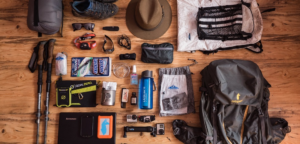
How to pack a backpacking pack for a Multi-Day Hiking Trip
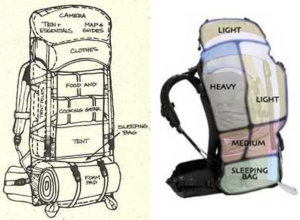 Packing a backpack is the big goal for every adventure junky and if it is a multi-day hiking trip, immaculate organization and storage of each item is necessary. This enables ease of locating them besides being comfortable on shoulder blades as the load is scientifically spread. To increase the comfort on the trail, strategically placing specific items makes the load feel lighter. Listed below are a few tips and methods of packing the backpack that would help store everything one might need on trekking trip without experiencing an ache in the neck or back.
Packing a backpack is the big goal for every adventure junky and if it is a multi-day hiking trip, immaculate organization and storage of each item is necessary. This enables ease of locating them besides being comfortable on shoulder blades as the load is scientifically spread. To increase the comfort on the trail, strategically placing specific items makes the load feel lighter. Listed below are a few tips and methods of packing the backpack that would help store everything one might need on trekking trip without experiencing an ache in the neck or back.
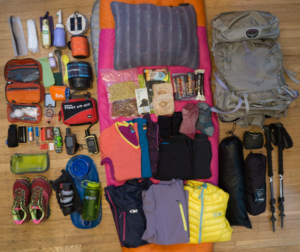 Piling and compiling the stuff
Piling and compiling the stuff
Pile the stuff needed such as shelter/sleeping bag, food, cooking gear, clothes and other small stuff needed during daytime such as sunscreens, batteries, flashlight, etc. This will ensure that neither items are left nor extra items are taken. While exploring Sydney’s wilderness, get in touch with best roof racks Sydney has to offer to get a customised roof rack installed on your vehicle for adventurous trips and have ample of space to carry the luggage safely. These racks are ruggedly constructed for professional adventurers who explore the wildest terrains having extreme road conditions.
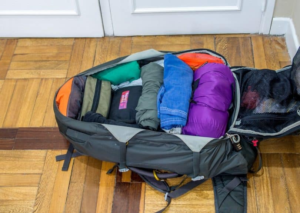 Divide and organize stuffing in layers
Divide and organize stuffing in layers
A good rule for packing in a systematic manner is to divide the backpack into three layers namely bottom, middle and top. Always pack the bottom first followed by keeping the heavier things in the centre and hive up the top with the light essentials for the trip.
Bottom’s Layout
Things required lastly and are lightly weight gear such as sleeping bag, item for camp, loose clothing, etc. can be kept at the bottom of the backpack.
If the hiking trip is in the rainy areas, it’s always better to line the backpack with the trash bag so that the items stay dry. Use lightweight waterproof compression sack for keeping the sleeping bag dry. If you are taking a sleeping pad along that is bulky by construction, save the space inside the backpack by strapping the same on the outside of the bag.
The right stuff for the middle layer
The middle section of the backpack is heavy items accommodating space. All the cumbersome items such as stove and fuel, pots and pans, food, camp mugs & shoes, toiletries, and bear canisters, etc. are stuffed here. Using such an arrangement will relieve the backpack from unnecessary strain and stress.
Stuffing clothes and other small items such as tent body, rain fly around the bear canister can help it stuck in the centre. Keeping the foodstuff in the middle layer also protect it from rodents.
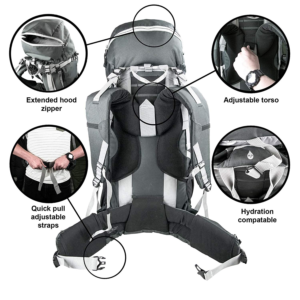 Crowning the backpack with accessories
Crowning the backpack with accessories
Use the top or uppermost compartment of the backpack, that is usually removable, as a daypack during hiking sessions.
It should accommodate cooking gear, an extra layer of clothes and other small accessories/necessities such as sunglasses, a first-aid kit, quick snacks, compass, rain jacket, water filter, bathroom kit, electronics. Carry lightweight small sized dry sack to store the electronics in this section.
The lid usually referred to as ‘the brain’ of the backpack should store map, headlamps, camera, quick snacks, multi-tool kit, sunscreen, a small-sized bug spray and other utilities needed as hands-on. Hip belt pockets are also ideal to store such stuff as it has zippered pouches attached.
If the hiking partner is Honda Africa Twin bike, even the heaviest backpack can be easily crowned on its aluminium luggage plate supplied with stainless steel clamps and bolts.
Snug fitting by tightening compression belts
The compression straps on the exterior of the backpack perform the function of stabilizing and adjusting the weight as per the requirement. Make sure that these are loose while packing is in progress. After packing, buckle and tighten up the straps. Tightening ensures that the stuff inside the backpack does not shift while hiking. The straps help hiker stay steady on uneven terrains as the weight of the backpack doesn’t shift while moving. Tighten the side compression straps to eliminate the empty spaces in the sides of the backpack.
The compression straps on the main exterior buckle should be fastening the brain of the backpack in a compressed manner so that it stays stationary during trekking.
A mid-sized backpack designed for intermediate distance is ideal for hiking on KTM bikes having free load storage on the outside and ample of internal storage space too. These are available as KTM parts online on genuine bike accessories selling sites.
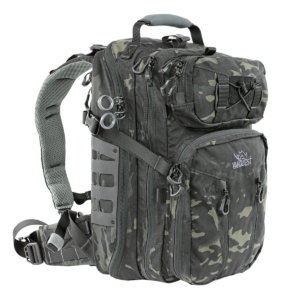 The loose loops on the exterior
The loose loops on the exterior
Utilize the loops on the exterior of the backpack to secure long, stiff and heavy items such as folding trekking and tent poles, ropes, shovels, or lightweight collapsible seat. Hook carabiners, clips, and other not-so-heavy gears on these loops. But take due care as this stuff will keep on hanging or swinging back and forth, hitting the surroundings often.
Conclusion
Get the backpack stuffed with desired stuff but keep it well organized so that the weight doesn’t fall heavily upon the shoulders and hiking trip stays memorable in a joyous tone.
Author’s Bio:
Harold Camaya is a marketing enthusiast and an influencer in Different verticals. She keeps special interest in the impact of visual branding on business growth. She has been writing for a long time now and has a interest in traveling as well.
Another great resource is https://campgrasp.com/beginners-guide-to-backpacking/
SIGN UP FOR OUR NEWSLETTER
© 2023 Wendi’s Tips. All Rights Reserved. Website by Noventum

